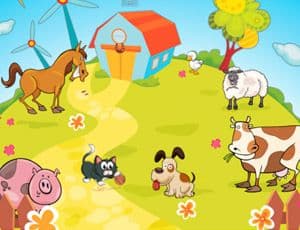Escola Games | Jogos Educativos
https://www.escolagames.com.br
Teacher's support sheet

Domestic Animals
Hello little friend!!
In this game we will meet various domestic animals. Which one is your favorite?
Slide the tracks to assemble the domestic animals and learn a little more about each one of them!

Teacher's tips
Level of education: Elementary School
Subject: Sciences
Age: 04 to 07 years old
The game brings images and information about animals that live very close to man, arousing the curiosity of children, who, encouraged by the puzzles, develop cognitive, visual, motor and social skills! The Game has two levels of difficulty helping in the specific development in each stage. The game is an excellent ally to Science classes! [FIM-DICA]
Learner outcomes
Develop motor skills;
Develop logical reasoning;
Analyze figures and expand the notions of composition and decomposition from the fragmentation of an image;
Develop discrimination and visual perception;
Know what domestic animals are;
Know some species of domestic animals and their main characteristics;
Recognize the uses of animals for humans;
Teachers' goals
Work on logical reasoning, observation, critical and reflective analysis;
Evidence of discrimination and visual perception, through the analysis of the pieces and their positions in the puzzle;
Enable the development of different thinking skills, such as observation, comparison, analysis and the ability to synthesize;
Complement the study on domestic animals;
Offer the game as a didactic resource to fix the content worked in the classroom;
Expand students' knowledge;
Work with students on motor skills
Work attention, concentration;
Suggestions of approaches for the teacher
(Suggestion 1) Before proposing the game, take pictures of different domestic animals to the room, including those that appear in the game: pig, sheep, chicken, goat, horse, cow, cat, dog, duck and rabbit. Compose a poster to hang in the room throughout the study on domestic animals.
(Suggestion 2) To play, it is important that the children are divided into pairs. Sometimes one mounts an animal, sometimes the other. The game has two levels: EASY and HARD. Easy level brings different background colors for each animal. This way, the child has “help” to assemble each animal. It is ideal for the proposal with smaller children. After playing at the easy level, propose the game at the difficult level, as in a didactic sequence.
For older children, aged 8 and 9, the proposal should only be on the difficult level.
(Suggestion 3) For children who are at the alphabetic level and are good at writing, propose a short summary, in topics, of the main information for each animal. Use ½ sheet of A4. Propose the registration of 2 animals for each day that the children play. Then, gather all the records and staple them, forming a small book of domestic animals.
(Suggestion 4) Take one of the animals that appears in the game to the living room. Dog or cat are the easiest to get. It is important that the animal is docile so that children can pass their hand, get close, observe, ask questions.
(Suggestion 5) For children from the Rural School or those with easy access to rural properties, it's worth taking the students for a walk!
(Suggestion 6) Print several drawings and ask students to outline them using string or colored yarn.
(Suggestion 7) Assemble a mosaic of animals with magazine clippings.
(Suggestion 8) Work on the 7 mistakes game.
(Suggestion 9) Work with figure discrimination, for example, print several shuffled animals on a sheet, place some animals facing to the right and some to the left. Inform the correct template, whether it is animals facing right or left. Then ask students to color the animals that are incorrect.
(Suggestion 10) Introduce students to diseases that are transmitted by domestic animals. Promote an awareness morning/afternoon with lectures, folders, theaters.
(Suggestion 11) Promote mime games where students should imitate a domestic animal so that classmates can guess.
(Suggestion 12) Play the Mico game.
(Suggestion 13) Ask students to make pictures illustrating with photographs the difference between domestic animals, domestic pets, wild animals, savannah animals...
More about the content
Before starting the study or Project on this topic, it is important to work with the concept of DOMESTIC ANIMALS. Many people confuse, thinking that these pets are just those that we can raise at home, but in fact domestic animals are all those that can be tamed by man and therefore live with them.
Among the domestic animals are the cat, bird, dog and also horses, chickens, cows, goats, etc.
Within the class of domestic animals we find companion animals, which are those that humans have at home. Whether it's a cat or dog, a bird or rodents, these animals almost become family members.
Below we indicate two sites with various pedagogical activities on domestic animals.
Get to know other games to work on the theme of Animals:
Savannah animals
https://www.bestschoolgames.com/games/savannahAnimals/
Wild animals
https://www.bestschoolgames.com/games/wildAnimals/
Animals Puzzle
https://www.bestschoolgames.com/games/animalsPuzzle/
Animals
